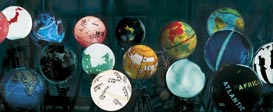Courses
- The Courses submission deadline was 19 May 2008.
- Overview
- Frequently Asked Questions
- Submission Rules & Requirements
This brief overview will help familiarise contributors with features of the SIGGRAPH Asia 2008 Courses programme.
Context
SIGGRAPH Courses have been central to the conference for 30 years. They are prepared presentations focusing on the theory and practice of computer graphics and interactive techniques. Course attendance may range from a couple hundred to a couple thousand depending upon topic interest.
Presentation
Course presentations provide a variety of learning perspectives and materials to engage their audiences. Presenters use text, images, video, animation, and other techniques to lead participants through concepts and ideas. Additionally, some courses provide interactive materials that attendees can access with their own computers via prior download or through wireless networks (if supported for a specific conference year).
Course Notes
Each course organizer prepares electronic course notes and supplementary materials for conference publications. Attendees use these learning materials both at the conference presentation and after the event. Carefully prepared course notes contribute substantially to the success of SIGGRAPH Courses. They are also highly regarded resources for the SIGGRAPH community after the event.
Audience
Course presenters are experts in their given field or practice. As part of their submission, they must scope the general complexity of the material for a given audience (beginners, intermediate, and advanced). Courses for beginners usually require basic pre-requisite knowledge and provide substantial context for introduction. Intermediate material usually requires specific skills and experience to ensure success with concepts being presented. Advanced courses provide in-depth focus on sophisticated ideas and are usually targeted at highly skilled individuals.
Formats
While many courses follow traditional lecture formats, course proposals are not limited to this style of presentation if the material is better suited to other presentation styles (interactive audience participation, for example). Content varies, too, from broad topic surveys to very specific details of a given theory or technique.
Length
Courses have one of three fixed-format lengths: full-day (seven hours), half-day (3.5 hours), and tutorial (1.75 hours). Each proposal format includes travel and lodging support for a limited number of presenters. Any additional presenters must find their own travel and lodging support to present at the conference.
More information: Courses Expense Policy
Organisation
Course proposals start with a course organiser. This individual identifies a topic of relevant interest to the SIGGRAPH conference community. The organiser designs a presentation outline and recruits qualified experts to present specific topics. All members of the course contribute to designing and executing the final course notes and materials if the proposal is selected for presentation.
Process
Course organisers create an electronic proposal for juried review by the courses committee. Proposal requirements include providing abstracts and a syllabus, identifying qualified presenters, demonstrating a course notes sample, preferably with input from all presenters, and outlining special requirements of the presentation (for both the conference and audience). This material is peer-reviewed by volunteers in the professional and academic communities. The courses jury conducts final selection based on the reviews, scheduling constraints, and the goal of building a balanced courses program. For the selected courses, the committee works with the organisers to ensure successful delivery and execution of their courses at the conference.









